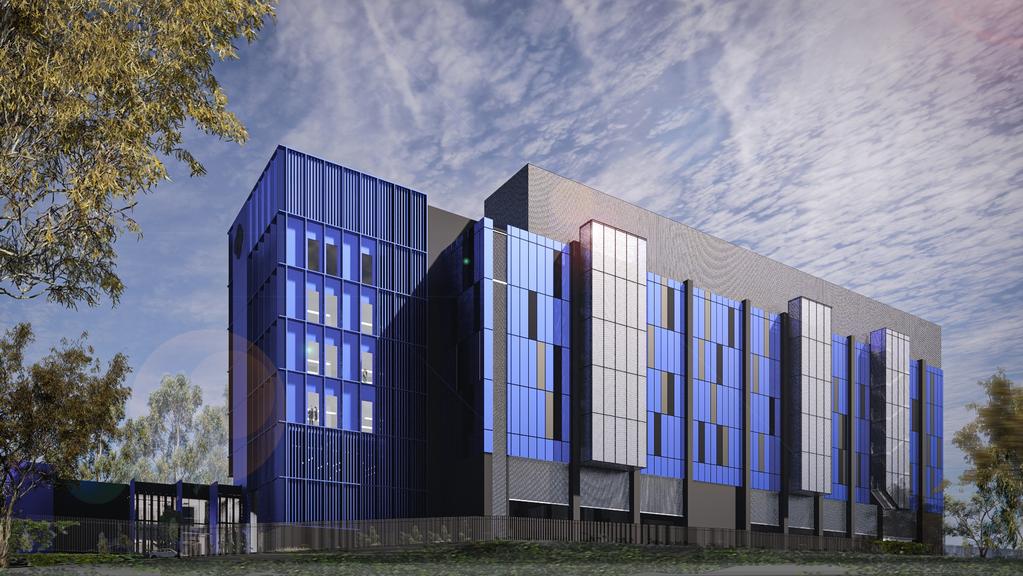How digital real estate is powering ahead in the AI age

Macquarie’s $350m IC3 Super West data centre.
The rapid advancement of artificial intelligence, the growth in cloud and edge computing, the widespread use of web-enabled devices, and the proliferation of e-commerce and streaming services is leading to exponential data creation and storage.
It is estimated that 90 per cent of the world’s data has been generated in the past two years, with projections indicating that we will produce twice as much data in the next five years as we have in the past decade.
This phenomenal growth has resulted in an unprecedented demand for data centres.
No longer mere digital storage facilities, data centres are now recognised as critical infrastructure that supports various sectors such as financial services, healthcare, education to advanced manufacturing.
According to NextDC, one of Australia’s leading data centre owners and operators, historically, the data centre market grew between 2017 and 2023 at a compound average growth rate (CAGR) of 15 per cent, supported by digitisation and cloud migration megatrends. The emergence of AI and the rapid pace of adoption is forecast to accelerate market growth to 19 per cent CAGR between 2024 and 2027.
Jon Gray, COO of Blackstone, the world’s largest real estate investor, stated: “Data centres are experiencing once-in-a-generation demand growth, driven by cloud adoption and the AI revolution. Digital infrastructure is one of our highest conviction investment themes as a firm.”

Blackstone chief operating officer Jon Gray. Picture: John Feder
Australia is widely acknowledged as a significant market for data centres. According to Cushman & Wakefield’s 2024 Global Data Centre Market Comparison, Sydney achieved a ranking of ninth among the top 10 global data centre markets and third in the Asia-Pacific region.
The ranking is based on 14 key factors such as power availability, land price, fibre connectivity, and cloud availability/operator presence.
Cushman & Wakefield positions Sydney as the 17th largest market by operational IT load. However, going forward, the city ranks sixth in terms of combined IT load under construction or plans filed.
Sydney’s strategic advantage lies in the multiple subsea cables connecting the city to various international locations. Currently, the city is served by 11 cables, with three more slated for completion by the end of 2026.
AI relies on high-performance computing and generates and consumes vast amounts of data, all of which needs to be processed, analysed and stored efficiently. In short, AI is power-hungry.
According to the Electric Power Research Institute, a ChatGPT query uses 10 times more energy than a standard Google query.
In order to cater to these needs, data centres require access to dependable high-density power, backup generators to ensure uninterrupted operations, and access to optical fibre and low-latency networks, the highways that connect data centres together, for efficient data transfer and communication between servers. It’s all about ensuring consistent connectivity and resiliency for customers.
The growing power needs of data centres, particularly larger hyperscale facilities, are putting a strain on the power grid. Not surprising that power has become a critical consideration for both data centre operators in their site selection and for electricity providers in their network planning.

NextDC says the data centre market grew between 2017 and 2023 at a compound average growth rate of 15 per cent.
Endeavour Energy which principally operates in Western Sydney, pointed out to the Australian Energy Market Operator (AEMO) that “As of December 2023, we have data centres totalling 0.6GW in connected load capacity from 16 different customers. This has increased significantly in recent years with 19 applications totalling 2.6GW in 2023. In addition to the applications, in December 2023, there were 18 additional inquiries totalling a further 2.7GW of connected load.”
“If realised, we expect data centres alone to reach a peak demand of 5.9GW, representing over 250 per cent of our total network demand today. We consider data centres warrant additional consideration relative to ordinary commercial and industrial load growth due to this rapid growth and their uniqueness.
“Data centres typically have stable, predictable load patterns and operate on a 24/7 basis. However, they tend to ramp up their operations far quicker than other large energy users and have intense energy consumption needs, consuming 10 to 50 times the energy per floor space of a typical commercial office building.”
Data centres also consume a significant amount of water for cooling. Newer central processing units (CPUs) and graphics processing units (GPUs) produce more heat, making traditional air cooling systems inefficient. As a solution, data centres are transitioning to liquid cooling systems for efficiency and sustainability.
In recent years, land availability has become limited in major markets such as Sydney and Melbourne. There’s intense competition for sites among data centre companies and other land users such as industrial and retail users. The price of land with ample power, fibre connectivity, proper zoning, and water and sewage management has been steadily increasing.
The growing demand for data centres has resulted in an expanding development pipeline. This is leading to more, and larger centres, with capacities greater than 100MW.
Morgan Stanley estimates the Australian data centre market is set to more than double by 2030 to about 2500MW with a number of projects in excess of 100MW.

Goodman Group chief executive Greg Goodman. Picture: John Feder
Given the challenge of finding suitable sites, the major technology companies such as Microsoft and Amazon, and the data centre operators, are increasingly seeking partnerships with real estate groups as it becomes more difficult to secure well-located and serviced land in key markets such as inner and western Sydney and inner Melbourne.
In the digital age, one of the standout winners in the real estate sector is industrial giant, the Goodman Group.
At its half year results in February, Goodman announced it had the power capacity to develop a global portfolio of data centres worth $80 billion over the next five to seven years.
It has added 300MW to its capacity since November 2023, bringing its total availability to 4GW. That power capacity is split globally, with 200MW available in Los Angeles, 1.5GW available across Europe and the UK in locations including London, Amsterdam, Frankfurt, Paris, and Madrid, 1.5GW available, and 300MW delivered in Asia across Tokyo, Osaka, and Hong Kong, and 400MW available and 200MW delivered in Australasia in Sydney, Melbourne, and Auckland.
CEO Greg Goodman emphasised that data centres will be a “key area of growth”. “Our growth in data centre capacity underscores our ability to deliver digital infrastructure, where we’re securing power on our sites and developing data centres in cities with high demand,” he added.
Since first disclosing its data centre pipeline in August 2023, Goodman’s share price has increased 80 per cent versus the A-REIT Index which has increased 27 per cent.
NextDC, an owner and operator of data centres, has also rewarded its shareholders. Since August 2023, its share price is up more than 40 per cent, while Global Data Centres, another ASX listed owner of data centres and digital infrastructure, is up 110 per cent over the same period.
There is no shortage of capital chasing the sector.
CBRE’s latest Global Data Centre Investor Survey found that 97 per cent of respondents to this year’s survey, many of whom are the world’s largest institutional real estate investors, planned to increase their capital deployment in the data centre sector this year.
Currently, 38 per cent of respondents have less than 5 per cent of their assets under management invested in data centres. However, just 8 per cent of the respondents expect to have less than 5 per cent of their assets in data centres in five years.

Charter Hall Direct Property Management chair Adrian Harrington.
The digital real estate landscape is rapidly transforming due to the proliferation of technology and data. Data centres will continue to adapt to increasing demands driven by AI technology, requiring changes in design and operations to improve efficiency and minimise environmental impact. Real estate investors and developers partnering with major technology companies and data centre operators can position themselves at the forefront of this dynamic era.
Adrian Harrington is chair of Charter Hall Direct Property Management and a senior adviser to Lighthouse Infrastructure







